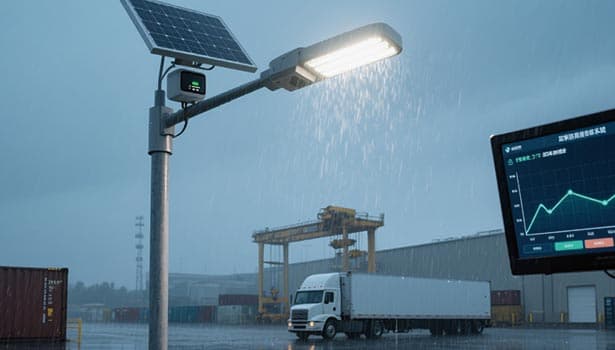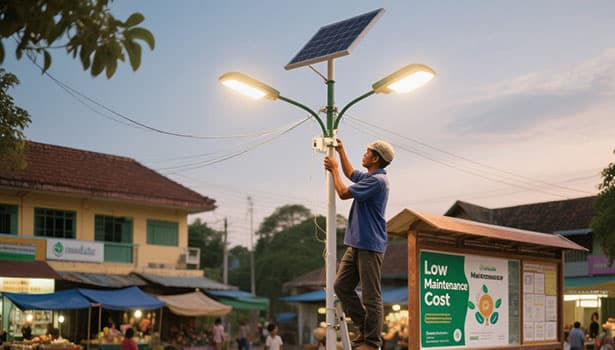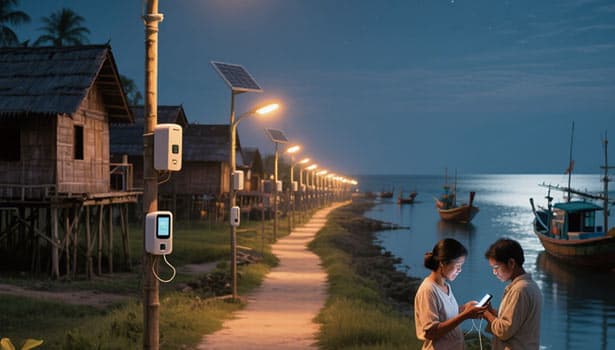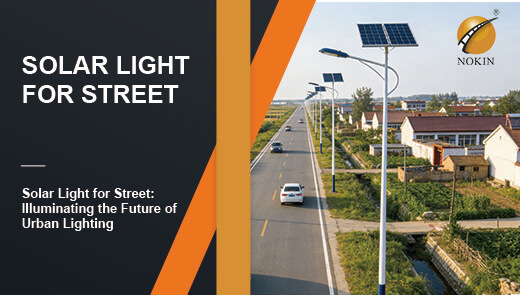Why Choose Solar-Powered Dusk-to-Dawn Street Lights?
Nighttime lighting is the fundamental guarantee for the operation of cities and the safety of rural areas. However, for a long time, traditional grid-powered street lights have been Mired in multiple predicaments and have become a "burden" for municipal authorities, property management companies and other units.
Traditional street lights rely on urban power grids for power supply, and the annual electricity bill often amounts to hundreds of thousands of dollars, exerting considerable pressure on financial and operational costs. During installation, large-scale ground excavation and complex wiring laying are required. This not only leads to a long construction period, but also damages the road surface and affects traffic. More importantly, it is completely dependent on the power grid. Once extreme weather conditions such as hurricanes and heavy rain cause power outages, the street lights will "collectively go on strike", directly threatening the safety of night travel.
Meanwhile, traditional street lights mainly rely on fossil energy for power generation, which indirectly produces pollutants such as carbon dioxide and sulfur dioxide during operation, running counter to the current "dual carbon" goals.
Against such a background, Solar-Powered Dusk to Dawn Street Lights emerged. It uses solar energy as its power source and is equipped with an automatic dawn and dusk sensing function, fundamentally solving the pain points of traditional street lights and becoming the preferred solution for sustainable lighting at present.

Solar-Powered Dusk to Dawn Street Lights Protect the Ecology
Under the global trend of "carbon neutrality", the environmental protection attributes of lighting equipment are becoming increasingly important, and solar-powered dusk to dawn street lights are typical representatives of "green lighting".
"Zero-Emission" Operation
The core working principle of solar-powered dusk to dawn street lights is to directly convert sunlight into electrical energy through the photovoltaic panels on the top and store it in the battery. The entire energy conversion process does not require the combustion of fossil fuels and does not involve any pollutant emissions - neither does carbon dioxide exacerbate the greenhouse effect, nor does sulfur dioxide, nitrogen oxides and other substances damage air quality.
Compared with the traditional street light process of "power supply from the power grid (mainly fossil energy generation) → line transmission → lighting", solar street lights cut off the pollution chain from the source of energy. According to estimates, a single 100W solar-powered dusk-dawn street light can reduce carbon dioxide emissions by approximately 120kg annually, which is equivalent to the carbon sequestration of six mature trees.
Facilitate the transformation of the energy structure
In the global power structure, although the proportion of renewable energy continues to increase, fossil energy (coal, oil, and natural gas) still holds a dominant position. The large-scale use of traditional street lights has indirectly increased the demand for fossil energy.
solar-powered dusk-dawn street lights use the inexhaustible sunlight as their energy source and can directly replace part of the power grid electricity, reducing the consumption of fossil energy. For remote areas or regions with weak power grid coverage, it can even "operate independently of the power grid", avoiding the construction of additional transmission lines for power supply .
High Investment Return of Solar-Powered Dusk to Dawn Street Lights
Many people are concerned about the "high initial investment" of solar street lights, but from a long-term operation perspective, their cost advantage far exceeds that of traditional street lights. We visually compare the cost structures of the two through a table:
|
Cost Type |
Traditional Street Lights (100W) |
Solar-Powered Dusk and Dawn Street Lights (100W) |
Core Difference Analysis |
|
Initial Investment (including installation) |
Lower |
Higher |
Solar street lights require more upfront investment due to photovoltaic panels and batteries. |
|
Annual Operating Cost (electricity bill) |
Yes, and it keeps increasing |
No |
Solar lights rely entirely on solar power, eliminating electricity bills and saving fixed annual costs. |
|
Annual Maintenance Cost |
Higher |
Lower |
No external transmission lines reduce maintenance work such as line inspection and fault detection, lowering costs. |
|
Life Cycle Cost (calculated over 10 years) |
Higher |
Lower |
Although the upfront cost is higher, “zero electricity + low maintenance” results in a lower 10-year cost; some high-end models are comparable to traditional. |
|
Investment Return Cycle |
None (continuous electricity bill payments) |
Exists (varies by sunlight availability) |
In sunny areas (e.g., arid regions), payback is faster; in low-sunlight areas, longer but still cost-effective in the long term. |
As can be seen from the table, although the initial investment in solar-powered dusk to dawn street lights is relatively high, most regions can achieve cost overtaking within 10 years thanks to the advantage of "zero electricity cost + low maintenance cost". Moreover, the longer the service life (the core components of high-quality solar street lights can last for 15 to 20 years), the more obvious the cost advantage becomes.
Take the renovation of 500 street lights in a certain county of California, USA as an example: After switching to solar-powered dusk-dawn street lights, an annual electricity cost savings of $27,500 to $36,500 and maintenance costs of $4,000 to $5,000 can be saved, totaling an annual savings of $31,500 to $41,500. The initial additional investment can be covered within five years, and there will be almost no operating costs in the following 10 to 15 years.

Solar Dusk to Dawn Street Lights: Low Maintenance and High Safety
The maintenance of traditional street lights has always been a major concern for operators. However, solar-powered dusk to dawn street lights, through "wireless design + simplified structure", have fundamentally reduced maintenance pressure and safety risks.
No Wires = Fewer Malfunctions
The malfunctions of traditional street lights are mostly caused by wiring issues: aging underground lines, short circuits due to rainwater immersion, and external force damage (such as excavation during construction). Each repair requires digging up the road surface and inspecting the lines, which not only takes a lot of time (a single repair often takes more than half a day), but also affects traffic and residents' lives.
The solar-powered dusk to dawn street light adopts a "wireless design", eliminating the need to lay power transmission lines. Its core components only include photovoltaic panels, batteries, lights, and sensors. The structure is simple and has low correlation. Daily maintenance only requires: Clean the photovoltaic panels once every 1 to 3 months (remove dust and leaves to ensure lighting). Check the battery connection once a year - the entire process does not require damaging the ground, and a single person can complete the maintenance of a single battery within half an hour.
According to statistics, the average annual failure rate of traditional street lights is about 2 to 3 times per light, while that of solar-powered dusk to dawn street lights is only 0.3 to 0.5 times per light, with a maintenance efficiency increase of over 80%.
Eliminate the Risks of Electric Shock and Overheating
traditional street lights, due to problems such as exposed and aged circuits, are prone to the risk of "leakage" during the rainy season or in damp environments. This not only may cause electric shock accidents but also may lead to overheating of the lights and fires due to short circuits in the circuits.
The working voltage of solar-powered dusk to dawn street lights is mostly 12V or 24V low-voltage direct current, which is far lower than the safe voltage for the human body (36V). Even if you touch the light or its components in rainy days, it will not cause electric shock. Meanwhile, its lights adopt a sealed design, with a waterproof rating of IP65 or above, which can effectively prevent rainwater from entering the interior and causing short circuits and overheating, significantly enhancing safety.
Solar Dusk to Dawn Street Lights Have Independent Energy Sources
The stability of power supply directly determines the reliability of street lights - and the "energy independence" of solar-powered dusk to dawn street lights precisely addresses the pain point of traditional street lights that "power outages cause them to stop working".
Do Not Rely on the Power Grid
The energy of solar-powered dusk-dawn street lights comes entirely from sunlight: during the day, photovoltaic panels generate electricity and store it in batteries. In the evening (dusk), the lighting is automatically turned on through sensors, and in the early morning (dawn), it is automatically turned off. The entire process does not require connection to the urban power grid.
This means that it can operate stably, whether in remote villages not covered by the power grid or in the suburbs of cities with tight power grid loads, without waiting for power grid renovation or expansion.
Solar Dusk to Dawn Street Lights Ensure Emergency Lighting
Extreme weather conditions such as hurricanes, heavy rain and heavy snow often cause damage to urban power grid lines and power outages. Once traditional street lights are out of power, they become unusable, which brings great inconvenience to emergency rescue at night and residents' travel.
Solar-powered dusk to dawn street lights, equipped with large-capacity batteries (which can usually store 3 to 7 days' electricity consumption), can maintain lighting even during continuous rainy days (with insufficient light) through battery power supply. When there is a power outage in the power grid, it can operate independently and provide emergency lighting for areas such as roads, residential communities and hospitals.
For instance, when Hurricane IDA affected Louisiana in the United States in 2021, the power grid in some areas was cut off for over a week. However, the community roads equipped with solar-powered dusk-dawn street lights could still maintain night lighting, providing a guarantee for the passage of rescue vehicles and the evacuation of residents.
Simple Installation of Solar Dusk to Dawn Street Lights
The installation of traditional street lights is limited by "line laying", and many scenarios (such as mountainous areas, wetlands, and temporary construction zones) are difficult to cover. However, the "wireless + lightweight design" of solar dusk to dawn street lights makes installation simple and flexible.
Does Not Require "Trenching and Wiring"
The installation process of traditional street lights is complex: it requires first surveying the route, excavating the ground (usually 0.5 to 1 meter deep), laying cables, backfilling the road surface, and connecting the lights. The installation of a single street light takes 2 to 3 workers 1 to 3 days. If it involves a main road, traffic control needs to be applied for, which affects traffic flow.
The installation of solar-powered dusk to dawn street lights only requires three steps:
- Pour the foundation of the streetlight (a small concrete base, with a diameter of about 30cm and a depth of about 50cm, which can be completed within one hour);
- Assemble photovoltaic panels,lights and batteries (pre-assembled in the factory, only connection and fixation are required on site);
- Pole fixation (can be completed by two workers within half an hour).
Full-Scene Adaptation
It is precisely because of its convenient installation and no reliance on the power grid that solar dawn-dusk street lights can be adapted to almost all lighting scenarios:
- Remote areas: such as rural roads in Africa, Amazon rainforest observation stations, and Australian inland pastures, lighting can be achieved without laying power transmission lines.
- Temporary scenarios: such as post-disaster reconstruction areas, large event venues, construction sites. Flexible installation and disassembly, and reusable.
- Sensitive areas: such as national parks, wetland reserves, and historical sites. Avoid excavating the ground to prevent damage to the ecological environment or cultural relics.
- Renovation of old buildings: For instance, in old urban areas of Europe and old communities in the Rust Belt of the United States, traditional street lights can be replaced without rewiring, reducing the difficulty of renovation.

Safety Upgrade of Solar Dusk to Dawn Street Lights
The core function of street lights is "illumination", and solar-powered dusk to dawn street lights further enhance the safety factor at night through "stable lighting + brightness guarantee".
Automatic Dusk to Dawn Sensing
The solar-powered dusk-dawn street light is equipped with a photosensitive that can automatically detect the ambient brightness: when the light drops to the set value (usually 10-20lux) at dusk, the light will automatically turn on. When the light rises to the set value at dawn, the lights automatically turn off - no manual switching is required, and there will be no energy waste due to forgetting to turn off the lights, nor will there be a "lighting blank period" caused by not turning the lights on in time.
Compared with the traditional "fixed-time switch" mode of street lights, it can automatically adjust the lighting time according to seasonal and weather changes (for example, in winter when it gets dark early, it will turn on earlier; in summer when it gets light early, it will turn off earlier), ensuring that the daily lighting duration precisely matches the actual demand. This not only guarantees safety but also avoids waste.
Improve Night Visibility
Adequate and stable lighting is the key to reducing traffic accidents and public security incidents at night. traditional street lights often experience "flickering brightness" due to aging circuits and unstable voltage, or "lighting blind spots" caused by faults in some lights, increasing safety hazards.
The solar-powered dusk to dawn street lights have stable brightness (constant output voltage), and the coverage area of a single light can reach 15 to 30 square meters (depending on the power), which can ensure that the visibility of roads and sidewalks is increased to over 50 meters.
Solar Dusk to Dawn Street Lights Balance "Energy Conservation and Convenience"
With the development of smart lighting, more and more solar-powered dusk-dawn street lights are equipped with intelligent functions, further enhancing the user experience and energy efficiency.
Motion Detection (Human Body Sensing)
Most mid-to-high-end solar dawn-dusk street lights are equipped with human body sensors, which can achieve "graded brightness control"
- Unmanned state: Thelights operate at a low brightness (such as 30% power) to meet the basic lighting requirements and save energy.
- When someone or a vehicle approaches: After thedetects the activity, it automatically increases to full brightness (100% power) to ensure clear visibility.
- When people or vehicles leave: After a delay of 30 to 60 seconds, it automatically returns to low brightness.
This design can significantly reduce energy consumption - according to tests, solar street lights equipped with human body sensing functions save 30% to 50% of electricity compared to always-on solar street lights, and the battery life can also be extended by 2 to 3 years.
Remote Monitoring and Management (for Some Models)
Some smart solar-powered dusk to dawn street lights support Internet of Things (IoT) connection and can be remotely managed through a mobile phone APP or a computer background.
- Real-time monitoring: View the operating status of each streetlight(lighting condition, battery power, fault alarm);
- Remote control: Adjust the lighting time and brightness level as needed (such as brightening during holidays and maintaining the basic brightness on weekdays);
- Fault Warning: When the battery power is too low or themalfunctions, the system automatically sends an alarm message to facilitate timely maintenance.
This intelligent management model can reduce the cost of manual inspection (without the need for staff to check one by one), and increase the operation and maintenance efficiency by more than 50%.




